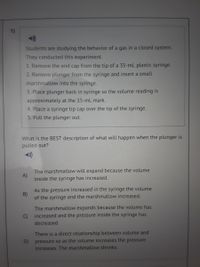Question

Transcribed Image Text:1)
Students are studying the behavior of a gas in a closed system.
They conducted this experiment.
1. Remove the end cap from the tip of a 35-mL plastic syringe.
2. Remove plunger from the syringe and insert a small
marshmallow into the syringe.
3. Place plunger back in syringe so the volume reading is
approximately at the 15-mL mark.
4. Place a syringe tip cap over the tip of the syringe.
5. Pull the plunger out.
What is the BEST description of what will happen when the plunger is
pulled out?
The marshmallow will expand because the volume
A)
inside the syringe has increased.
As the pressure increased in the syringe the volume
B)
of the syringe and the marshmallow increased.
The marshmallow expands because the volume has
increased and the pressure inside the syringe has
C)
decreased.
There is a direct relationship between volume and
pressure so as the volume increases the pressure
D)
increases. The marshmallow shrinks.
Expert Solution
This question has been solved!
Explore an expertly crafted, step-by-step solution for a thorough understanding of key concepts.
This is a popular solution
Trending nowThis is a popular solution!
Step by stepSolved in 3 steps

Knowledge Booster
Similar questions
- 5. A gas with volume V, pressure P, and temperature T is inside a container with a moveable piston. No gas is leaking from the container as the temperature of gas is quadrupled while the volume is doubled. What will be the new pressure? A. 2P B. P C. 1/2 P D. 8Parrow_forward7. The average kinetic energy of the molecules in an ideal gas increase with the volume remaining constant. Which of these statements must be true? a. both the pressure and the temperature increase b. the number density decreases c. the temperature increases, and the pressure stays the same. d. the pressure increases, and the temperature stays the samearrow_forwardName Chapter 20 Gases Boyle's Law A movable piston encloses 0.78 m³ of gas in a cylinder. The piston is then pushed downward, changing the volume of the gas to 0.36 m³ and the pressure to 2.8 kPa. What was the original pressure of the gas? 1. Read and Understand What information are you given? initial volume of the piston = V₁ = 0.78 m³ final volume of the piston = V₂ = 0.36 m³ final pressure of the piston = P2 = 2.8 kPa 2. Plan and Solve What unknown are you trying to calculate? original pressure of the piston = P₁ What mathematical equation can you use to calculate the unknown? Boyle's law: P₁V₁= P₂V₂ Rearrange the equation to solve for the unknown variable. P₂V₂ P₁₂₁= Substitute the values you know into the equation. (2.8 kPa) (0.36 m³) 0.78 m³ P₁ = e8 to enolisoit = 1.3 kPa of Woled surgit odi 3. Look Back and Check Is your answer reasonable? Yes, the final pressure, 2.8 kPa, is about twice the original pressure, 1.3 kPa. Origirst grwollo obsmot Math Practice On a separate sheet of…arrow_forward
arrow_back_ios
arrow_forward_ios